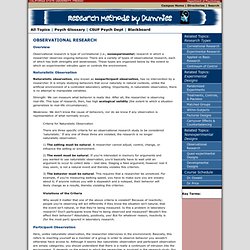

Informed Consent. Who can give informed consent? Informed consent is a legal agreement between researchers and participants. As such, participants must be competent to enter into a legal agreement to give informed consent. They must be at least 18 years of age and must not be considered legally incompetent (as would be the case if a person had a severe head injury, were mentally retarded, suffered from dementia or another mental illness). When working with individuals who have a limited or diminished capacity to understand an informed consent agreement, it is important to get consent from a legally authorized person as well as to obtain assent from the individual who will be participating. Children (minors) and adults who are not competent to legally give informed consent must be handled differently if they are to be recruited for a research project.
In some cases, permission must be obtained from additional sources. Informed Consent Concept Map or Top of Page. Observational techniques. In marketing and the social sciences, observational research (or field research) is a social research technique that involves the direct observation of phenomena in their natural setting. This differentiates it from experimental research in which a quasi-artificial environment is created to control for spurious factors, and where at least one of the variables is manipulated as part of the experiment. Observational techniques in context[edit] Three Approaches[edit] Generally, there are three types of observational research: In Marketing Research[edit] In marketing research, the most frequently used types of observational techniques are: See also[edit]
Observation techniques. One method of doing research is to ask people questions.

This is most people’s concept of what a survey involves. However, it’s possible to do research without asking questions, but simply observing respondents. This is called observation. There are two ways of doing observation: (1) Informal observation, also called unstructured or exploratory observation. . (2) Formal observation, also called structured or systematic observation. Informal observation When I’m sent to a country I’ve never visited before, and asked to organize a research program, usually one of the first things I do is some informal observation. This requires an attitude of openness to experience, and not taking anything for granted.
An example: when I visited New Guinea for the first time in 1991, I visited an adult education class for village women, near the town of Goroka. I had hardly noticed a distant siren, in Goroka: it is sounded every day at noon. Shops and markets are a good place for observation. Calculators: Observational Research. Overview Observational research is type of correlational (i.e., nonexperimental) research in which a researcher observes ongoing behavior.

There are a variety of types of observational research, each of which has both strengths and weaknesses. These types are organized below by the extent to which an experimenter intrudes upon or controls the environment. Naturalistic Observation Naturalistic observation, also known as nonparticipant observation, has no intervention by a researcher. Strength: We can measure what behavior is really like. Weakness: We don't know the cause of behaviors, nor do we know if any observation is representative of what normally occurs. Criteria for Naturalistic Observation There are three specific criteria for an observational research study to be considered 'naturalistic.' Violations of the Criteria Why would it matter that one of the above criteria is violated? Participant Observation Here are two famous examples of participant observation: